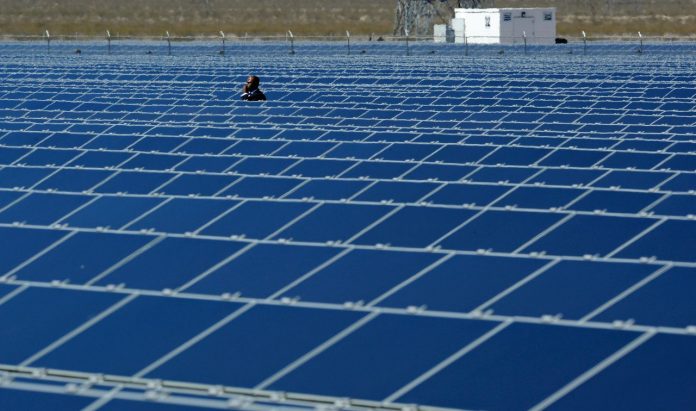Syracuse, N.Y. — Syracuse, one of the cloudiest cities in the U.S., is drawing lots of interest from solar farm developers.
Projects have been proposed recently for multiple solar energy projects in Syracuse suburbs, including these that came before the Onondaga County Industrial Development Agency just this week:
- In Cicero, Convergent Energy has proposed building two 5-megawatt solar farms on 44 acres off Totman and Island roads for $24.4 million.
- In Clay, Green Street Power Partners has proposed building a 5-megawatt solar farm on 30 acres at 9177 Caughdenoy Road for $8.1 million.
- In Lafayette, Green Street Power Partners has proposed building a 3.8-megawatt solar farm on 18 acres off Sentinel Heights Road for $6.1 million.
- In Lysander, OYA Solar has proposed building 5-megawatt and a 1-megawatt solar farms on 11 acres off Church Road for $11.3 million.
Solar farms are sites covered with solar panel arrays that turn sunlight into electricity. The power they generate is fed into the electric grid through power lines. (Though sometimes referred to as “non-wire” power generators, they are not completely wireless.)
They have the advantage of requiring no fuel and give off no emissions.
But Syracuse is the 14th cloudiest city in the nation, getting an average of only 46% of possible sunshine annually, according to National Oceanic and Atmospheric Administration data looked at by NerdWallet.
So why is Syracuse suddenly a popular place for solar farm developers? Solar industry officials cite three reasons.
First, there’s a lot of demand for solar power throughout Upstate New York, not just Syracuse. The Climate Leadership and Community Protection Act signed into law by Gov. Andrew Cuomo in July 2019 requires the state to obtain 70% of its electricity from renewable sources by 2030. The 70% goal is an increase from the state’s 50% target set in 2016.
“I would say that’s the main driver,” said Anne Reynolds, executive director of the Alliance for Clean Energy New York, whose members include solar, wind and hydroelectric companies and makers of electric vehicles.
Currently, 26% of the power generated in New York comes from renewable energy, mostly from hydroelectric plants. Only 1% comes from solar energy, Reynolds said.
Dozens of solar projects have been proposed in Upstate New York, which has plenty of vacant, rural land available for such developments. The biggest is a 200-megawatt project proposed in the Cayuga County town of Conquest that would stretch across 2,000 acres, or more than three square miles, and supply enough electricity to power more than 30,000 average homes.
As part of the state’s goals, Gov. Andrew Cuomo announced in 2018 a $1.4 billion commitment to advance 26 large-scale renewable energy projects, including 22 wind farm projects, across the state. The state also makes tax incentives available to solar projects.
Secondly, the cost of solar panels has come down in recent years, making solar energy projects more financially feasible.
Thirdly, solar panel technology has improved to the point that they can produce power even in areas of the country that do not get a lot of sunshine.
“The new panels can work not only on very sunny days, but they can work on cloudy days as well, not as well, but they still produce energy,” said Joseph Mendelsohn, project manager for Omni Navitas Holdings, which is partnering with Green Street Partners on the solar projects in Clay and Lafayette. “They can collect through indirect sunlight, which is something that they weren’t able to do not that long ago.”
The Sentinel Heights Road project proposed this week is one of four that are planned in rural Lafayette. Town Supervisor Daniel Fitzpatrick said the town is an attractive place for solar projects because it has a lot of open land to put them.
“They all kind of came at once,” he said.
Fitzpatrick said he expects to see even more proposed soon.
“I’ve been getting calls for developers from Boston, New York, Georgia and Nova Scotia,” he said.
The proposed projects are in various stages of approval. Fitzpatrick said the town is requiring that the projects are screened so they do not obstruct landscape views and that developers commit to removing them once they reach the end of their technological lifespan, which can be from 20 to 30 years.
Many of the developments are what are called community solar projects because the owners allow residential customers to benefit, through a subscription, from the electricity they generate.
Mendelsohn said customers who subscribe to Omni Navitas projects can obtain discounts of 5% to 10% off the electrical supply portion of their utility bills. (So, if the supply portion of a typical residential customer’s bill was $50 a month, the customer would save $5 a month, or $60 a year.)
Some projects will sell their electricity directly to the wholesale power suppliers in New York, who in turn sell it to utility companies. The Convergent Energy solar farms proposed in Cicero, for example, would send their power to National Grid to fill a need for more electrical supply during times of peak demand in the town, said Kevin McAuliffe, an attorney representing the company.
Each of the Cicero projects will include a battery system capable of storing 20 megawatts of power. The solar panels will charge the batteries during the day. When the power is needed, National Grid will draw electricity from them.






